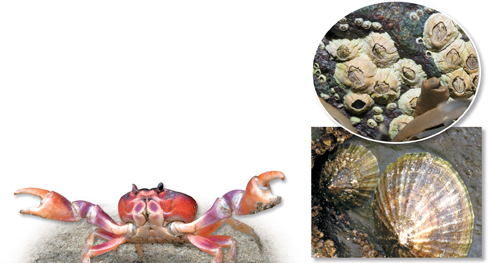Problems With Traditional Classification In a sense, members of a species determine which organisms belong to that species by deciding with whom they mate and produce fertile offspring. There is thus a “natural” definition of species. Researchers, on the other hand, define Linnaean ranks above the level of species. Because, over time, systematists have emphasized a variety of characteristics, some of these groups have been defined in different ways at different times.
For example, Linnaeus's strategy of classifying organisms according to visible similarities and differences seems simple at first. But how should scientists decide which similarities and differences are most important? If you lived in Linnaeus's time, for example, how would you have classified the animals shown in Figure 18–6? Adult barnacles and limpets live attached to rocks and have similar-looking shells. Adult crabs look quite unlike both barnacles and limpets. Based on these features, would you place limpets and barnacles together, and crabs in a different group? As biologists attempted to classify more organisms over time, these kinds of questions arose frequently.
Linnaeus was a good scientist, and he chose his characteristics carefully. Many of his groups are still valid under modern classification schemes. But Linnaeus worked more than a century before Darwin published his ideas about descent with modification. Modern systematists apply Darwin's ideas to classification and try look beyond simple similarities and differences to ask questions about evolutionary relationships. Linnaeus grouped organisms strictly according to similarities and differences. Scientists today try to assign species to a larger group in ways that reflect how closely members of those groups are related to each other.

FIGURE 18–6 Barnacles, Limpets, and Crabs Problems can arise when species are classified based on easily observed traits. Look closely at the barnacles (top), the limpets (bottom), and the crab (left). Notice their similarities and differences. Compare and Contrast Which animals seem most alike? Why?
18.1 Assessment

-
Review Identify two goals of systematics.
Explain Why do the common names of organisms—like daisy or mountain lion—often cause problems for scientists?
Classify The scientific name of the sugar maple is Acer saccharum. What does each part of the name designate?
-
Review List the ranks in the Linnaean system of classification, beginning with the smallest.
Explain In which group of organisms are the members more closely associated—all of the organisms in the same kingdom or all of the organisms in the same order? Explain your answer.
Apply Concepts What do scientists mean when they say that species is the only “natural” rank in classification?
Apply the Big idea
Which category has more biological meaning—all brown birds or all birds descended from a hawklike ancestor? Why?

Table of Contents
- Formulas and Equations
- Applying Formulas and Equations
- Mean, Median, and Mode
- Estimation
- Using Measurements in Calculations
- Effects of Measurement Errors
- Accuracy
- Precision
- Comparing Accuracy and Precision
- Significant Figures
- Calculating With Significant Figures
- Scientific Notation
- Calculating With Scientific Notation
- Dimensional Analysis
- Applying Dimensional Analysis




